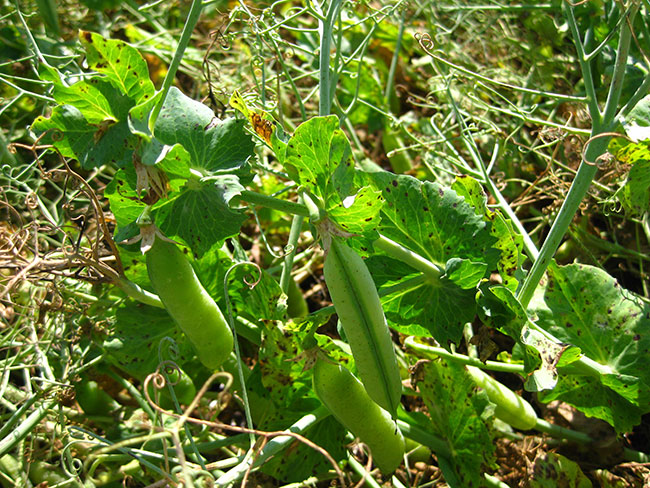
Features
Diseases
Managing Ascochyta in field pea
Research found no connection between seeding rate and fungicide response.
March 5, 2019 By Bruce Barker
 A yield response to foliar fungicide application for Mycosphaerella blight is environmentally driven.
Photo courtesy Barb Ziesman.
A yield response to foliar fungicide application for Mycosphaerella blight is environmentally driven.
Photo courtesy Barb Ziesman.
Ascochyta blight/complex is the most common disease of field pea in Western Canada. The disease can produce yield losses of more than 30 per cent. The disease is a complex of several fungi that cause leaf, stem and root rot systems including Ascochyta pinodes, Ascochyta pinodella and Ascochyta pisi. The sexual stage of Ascochyta pinodes is Mycosphaerella pinodes, and the disease caused by this pathogen is also referred to as Mycosphaerella blight.
To help develop control recommendations for the Ascochyta complex in Manitoba, where field pea production has lagged behind Saskatchewan and Alberta, a combination of small-plot and On-Farm Network trials were conducted by the Manitoba Pulse and Soybean Growers (MPSG).
“What we found was that environmental conditions were definitely the driver for a yield response with foliar fungicide applications,” says Greg Bartley, On-Farm Specialist with MPSG in Carman, Man. “We had a wide range of growing conditions from 2015 through 2018, and years with high rainfall often meant high disease pressure.”
Seeding rate confirmed
The research looked at seeding rate and foliar fungicide application impacts on yield. The current Manitoba Agriculture seeding rate recommendation is to target 70 to 80 live plants per square metre (seven to eight per square foot). Some growers may increase seeding rate to improve weed competition or overcome root rot pressure on fields at high risk. Increasing seeding rate, however, may increase the risk of disease because of the denser plant stand.
Small plot research trials conducted in Minto, Man., (2015 and 2016) and Hamiota, Man., (2016) tested seeding rates of 60, 80, 100, 120, and 140 seeds per square metre. Foliar fungicide treatments included a no fungicide control, one application of Headline EC at 10 per cent flower, or an application of Headline at 10 per cent flower plus Priaxor 12 to 13 days later.
At the three site years of small plot research, the optimum plant population that reached 95 per cent of maximum yield was between 74 and 96 plants per square metre. This was similar to the current Manitoba recommendation.
The small plot research did not find any interaction between seeding rate and fungicide application. Yield response to fungicide application varied by year.
“One thing to keep in mind is the yield potential and disease pressure between the two years. 2015 was an excellent year for peas with high yield potential and minimal disease. One fungicide application under these conditions was sufficient. In 2016, a very challenging year for field peas due to high rainfall and high disease pressure, two applications of fungicide was always beneficial,” Bartley says.
On-Farm Network trials reflect small plot fungicide findings
Manitoba Pulse and Soybean Growers conducts formalized On-Farm Network trials by involving farmers to test production practices using replicated strip trials. In 2017, a foliar fungicide trial was set up to compare no fungicide, one foliar fungicide application at early flower and two fungicide applications at early flower and seven to 14 days after the first application. Six farms participated in 2017 and five farms in 2018.
In 2017, the probability of a significant yield response to fungicide application was 75 per cent for one application and 25 per cent for two applications. 2017 was a dry year and disease pressure was low.
For 2018, Bartley says there was a yield response to fungicide at one out of five sites. He says yield potential was okay in certain areas but the lack of moisture reduced disease pressure for the most part.
What the small plot and On-Farm Network trials highlight is that environmental conditions impact disease development and the likelihood of a yield response to foliar fungicide application. To help guide the fungicide application process, Saskatchewan Pulse Growers has posted a fungicide decision support checklist on their website to help determine the risk associated with Ascochyta and Mycosphaerella blight in field pea. The crop is assessed at no later than the 10-node stage or 10 per cent flowering.
The checklist takes into consideration the crop canopy, leaf wetness/humidity, weather forecast and current visual disease symptoms. Farmers can use this checklist to help make spray decisions, or at least reference the checklist to think about the factors that influence disease development and the risk potential.
“Because Mycosphaerella blight is so weather-dependent, a yield response to foliar fungicide application really depends on environmental conditions and your risk tolerance. We will continue to explore this topic to refine recommendations in the future,” Bartley says.